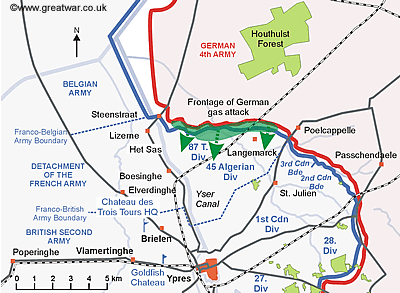 Gas cloud rolls through the French trenches
Gas cloud rolls through the French trenches
22 April 1915: 17.00
The gas cloud rolled through most of the French front line trenches of 87th Territorial Division and 45th Algerian Division. Gasping for air many of the French troops fled before it:
The experience of the Medical Officer of the 1st African Battalion, in the front line west of Langemarck village was as follows:“Stumbling and gasping in an agony of terror-stricken flight before it, scattered groups of French Algerian infantrymen with reeking, yellowed clothing and ashen purple faces, staggered across the fields, through hedges, over ditches and down the roads, regardless of everything but this unknown devil which had them by the throat. Their yellowed clothes reeked and their faces were ashen. With wild panic in their eyes they tried to escape from the murderous green mist.” (1)
“I had the impression that I was looking through green glasses. At the same time, I felt the action of the gas on my respiratory system; it burned in my throat, caused pains in my chest, and made breathing all but impossible. I spat blood and suffered from dizziness. We all thought we were lost. It grieved us to see poor Cordier. He was purple, incapable of walking.” (2)
A few French soldiers remained in their positions to try and fight it out. From within the impenetrable veil of poisonous fog the neighbouring Canadians could hear spasmodic rifle fire and machine-gun fire.

Colonel Mordacq was the commander of the three French battalions (of 90th Brigade) in the front line of 45th Algerian Division. At 5.20pm he received the first telephone calls at his command post in Elverdinghe from the front line battalion commanders telling him about the gas. He was puzzled at the gasping voices of his commanders, who said they were asphyxiated and were beginning to evacuate their trenches. A second telephone call from Major Villevaleix, commander of 1st Tirailleurs on the far right of the French line near the Franco-British Boundary reported:
“Everyone is falling around me, I am quitting my Command Post.”
Colonel Mordacq got on his horse and galloped in the direction of Boesinghe to see if he could see what was happening on the front line. When he got there he described how:
“... we were seized by a violent tingling in the nose and throat, the ears commenced to buzz, breathing became painful, and overwhelming odour of chlorine surrounded us.” (3)
In the village of Boesinghe he saw a tragic scene unfolding:
Colonel Mordacq didn't try to stop the French soldiers making their escape from the front line. He went through Boesinghe to the south to see what the situation was regarding the two main Yser Canal crossings at Boesinghe - one was a road swing bridge south-east of the main part of the village and the other was a railway bridge about 1 kilometre south of Boesinghe. He was relieved to find two companies of Zouaves were defending the canal crossings south of Boesinghe. Artillery officers, who had had to abandon their guns, implored the Colonel to launch an immediate counter-attack to recapture their field guns but he could only reply, “With whom and with what?” (5)“Everywhere were fugitives ... without weapons, haggard, greatcoats thrown away or wide open, running around like madmen, begging for water in loud cries, spitting blood, some even rolling on the ground making desperate efforts to breathe.” (4)
Report from the Canadian 2nd Brigade in the British Sector
A situation report sent at 5.25pm from the 2nd Canadian Brigade to 1st Canadian Division headquarters at Chateau des Trois Tours in Brielen reported the enemy bombardment and rapid French rifle-fire in response to the shock of the gas attack:
A German Soldier describes the field artillery bombardment“... Heavy bombardment and rapid rifle fire heard on our left at 5pm ...” (6)
Acknowledgements
(1) Official History of the Canadian Forces in The Great War 1914-1919, p. 229
(2) From Le Drame sur L'Yser by Colonel J J Mordacq, quoted in Gas! The Battle for Ypres, 1915, p. 45
(3) From Le Drame sur L'Yser by Colonel J J Mordacq, quoted in Gas! The Battle for Ypres, 1915, p. 47
(4) From Le Drame sur L'Yser by Colonel J J Mordacq, quoted in Gas! The Battle for Ypres, 1915, p. 47
(5) From Le Drame sur L'Yser by Colonel J J Mordacq, quoted in Gas! The Battle for Ypres, 1915, p. 47
(61) War Diary of 1st Canadian Division, April 1915 Appendices: ref. WO95/3717